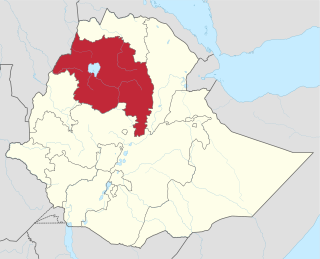History
Muja is one of the oldest town in the province of Lasta next to the mighty Lalibela. Muja was founded during the era of Zemene Mesafint by the notable Weresekh (ወረሴህ) rulers Dejazmach Birru Aligaz and Dejazmach Faris Aligaz both are the sons of Aligaz of Yejju (died 1803) and he was also the Ras of Begemder, and Inderase (regent) of the Emperor of Ethiopia for more than six years. [1] This makes the establishment of the town prior to the reign of Emperor Theodore II. A war account written by Adolf Parlasak who was the advisor of Ras Kassa noted Leul Ras Kassa Hailu was born in this town in 1878 and followed his childhood church educations in this town. [2] The British expedition against Emperor Tewodros II encamped near Muja in 1868, at a site referred to as "Muja Camp". Leul Ras Kassa's father Dejazmach Hailu Wolde Kiros made this town as an Administrative center of Lasta since from the reign of Emperor Tekle Giyorgis [3]
Lasta is a historic district in north-central Ethiopia. It is the district in which Lalibela is situated, the former capital of Ethiopia during the Zagwe dynasty and home to 11 medieval rock-hewn churches.
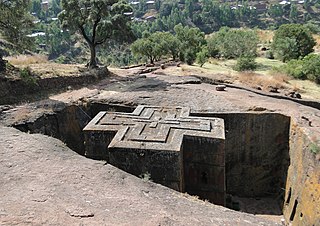
Lalibela is a town in Amhara Region, Ethiopia famous for its rock-cut monolithic churches. The whole of Lalibela is a large antiquity of the medieval and post-medieval civilization of Ethiopia. Lalibela is one of Ethiopia's holiest cities, second only to Axum, and a center of pilgrimage. Unlike Axum, the population of Lalibela is almost completely Ethiopian Orthodox Christian.
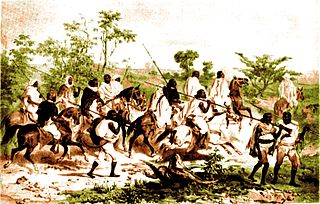
The Zemene Mesafint was a period in Ethiopian history between the mid-18th and mid-19th centuries when the country was de facto divided within itself into several regions with no effective central authority. It was a period in which the Emperors from the Solomonic dynasty were reduced to little more than figureheads confined to the capital city of Gondar.
During the Second Italo-Abyssinian War the Ethiopian army commanded by Leul Ras Kassa Hailu was camped in the town on their way to Tembien front. Muja was visited by Beatrice Playne around 1950, who found while the town "was really quite a large place and had once been flourishing", it now was had "a feeling of neglect and decay" since local government offices and the police station had been moved to a nearby settlement she called "Kulmus". Her description of Muja ends with the observation, "On the hill above the town a number of old Italian buildings, which had once served as government offices, were beginning to disintegrate." [4]
Tembien is a historic region in Tigray and one of the former provinces of Ethiopia. It is a mountainous area of that country. During the reforms in 1994-95, the old provinces were replaced with regions, zones and woredas. The area of the former province is now split over the woredas of Dogua Tembien and Kola Tembien.
Tekle Giyorgis II was nəgusä nägäst (Emperor) of Ethiopia from 1868 to 1871.
Tekle Giyorgis I was Emperor of Ethiopia intermittently between 20 July 1779 and June 1800, and a member of the Solomonic dynasty. He was the youngest son of Yohannes II and Woizoro Sancheviyer, and the brother of Tekle Haymanot II.
Hezqeyas or Hezekiah was niguse negest of Ethiopia, and a member of the Solomonic dynasty. He was the son of Iyasu III.
Baeda Maryam II was nəgusä nägäst of Ethiopia. He may have been the son of Salomon II. Although E. A. Wallis Budge, in his book A History of Ethiopia: Nubia and Abyssinia, notes some authorities believe Baeda Maryam was the same person as Salomon III, Nathaniel Pearce, who met the former Emperor when he visited Ras Wolde Selassie 20 January 1813, states that he had been Emperor only once, for nine months.
Yonas or Jonah was nəgusä nägäst of Ethiopia. He was the son of Letezum, and the grandson of the Emperor Fasilides.
Ali I of Yejju was a Ras of Begemder, and following the death of Ras Mikael Sehul, Regent of the Emperor of Ethiopia. He was the son of Abba Seru Gwangul, chieftain of the Yejju, and Woizero Gelebu Faris, daughter of Ras Faris of Lasta.
Ali II of Yejju was a Ras of Begemder and Enderase (Regent) of the Emperor of Ethiopia. He was the son of Alula of Yejju and Menen Liben Amede and nephew of Gugsa of Yejju.
Wolde Selassie was Regent of the Ethiopian Empire. He was the son of Dejazmach Kefla Iyasus, governor of Enderta province, and his wives included Mentewab, the sister of Emperor Egwale Seyon; and Sahin, the daughter of Emperor Tekle Giyorgis I. His brothers included Dejazmach Bilaten-Geta Mennase and Dejazmach Debbab, the great grand father of Emperor Yohannes IV.
The Battle of Debre Tabor was a conflict during the Zemene Mesafint in 1842 initiated by Dejazmach Wube Haile Maryam to overthrow Ras Ali II as Regent of the Emperor of Ethiopia and gain control of Ethiopia. This confused battle was won by Ras Ali, but at a steep price, and this victory failed to cement his position as the most powerful nobleman of his time.
The Battle of Takusa was fought on April 12, 1853, between the forces of Kassa Hailu, future Emperor of Ethiopia, and an alliance of several rival warlords. The forces of Hailu's enemies were led by Dejazmach Birru Aligaz, who was reinforced by troops sent to him by Wube Haile Maryam under the command of his son, Gwangul Wube.
The Battle of Ayshal was fought on June 29, 1853, between the forces of Kassa Hailu and the forces of Ras Ali II, in Ayshal, in eastern Gojjam. Kassa's forces won the battle.

Ethiopian forces in the Second Italo-Abyssinian War besides the Central Army were mobilized from various provinces under their local leader. According to 1935 Italian intelligence estimates of the Ethiopian provinces and their forces on the eve of hostilities, the Ethiopians had an army of 350,000 men. Strengths where known are noted followed by their leader. Modernized forces in Bold.
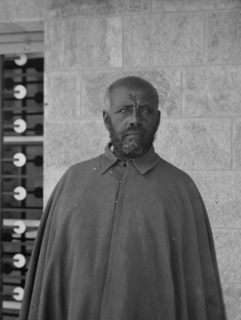
Leul Ras Kassa Hailu KS, GCVO, GBE, was a Shewan nobleman, the son of Dejazmach Haile Wolde Kiros of Lasta, the ruling heir of Lasta's throne and younger brother of Emperor Tekle Giyorgis II on his mother's side, and Tisseme Darge, the daughter of Ras Darge Sahle Selassie, brother of Menelik II's father.

Seyoum Mengesha KBE was an army commander and a member of the Royal family of the Ethiopian Empire.
Aberra Kassa was an army commander and a member of the Royal family of the Ethiopian Empire.
Asfawossen Kassa was an army commander and a member of the Royal family of the Ethiopian Empire.
Dejazmach Birru Aligaz was a warlord of 19th century Ethiopia during the Zemene Mesafint. As Dejazmach, he held the governorships of different districts such as Lasta and Dembiya and was made governor of Dawint, Wollo in 1842 by Ras Ali II of Yejju. He was the son of Ras Aligaz Abba Seru Gwangul, and had a son called Dejazmach Zegeye.
Dejazmach Zegeye Birru was the son of Dejazmach Birru Aligaz. He was the ruler of Yejju until the emergence of Ras Welle Betul. Dejazmach Zegeye had four sons and a daughter: Wagshum Gwangul, Dejazmach Ali, Dejazmach Hailu, Dejazmach Aligaz, and Woizero Hirut.
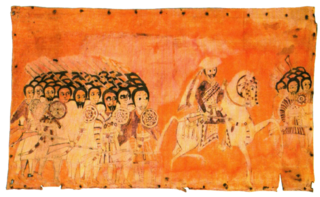
Wube Haile Maryam, also called Wube Haile Mariam or Dejazmach Wube, (1800–1867) was a regional ruler and dejazmach in Tigray, Simien, and other coastal territories, in an area that is now part of northern Ethiopia and central Eritrea. Wube is remembered in Eritrea for barbarous military raids. He was defeated and imprisoned in 1855 by Kassa Hailu. Some sources date Wube's defeat as the end of Ethiopia's Zemene Mesafint era.

